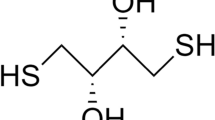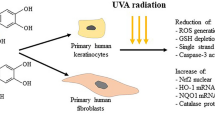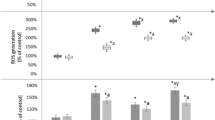Abstract
The exposure of cells to ultraviolet B radiation (UVB) can induce the production of reactive oxygen species (ROS) which damage cellular components. Free radical scavengers and antioxidants can interfere with the production of ROS. We studied cytotoxicity, intracellular ROS levels, lipid peroxidation, antioxidant status and oxidative DNA damage in cultured human skin dermal fibroblast adult cells (HDFa) exposed to UVB in the presence of sesamol, a natural phenolic compound. The levels of cytotoxicity, intracellular ROS, lipid peroxidation, oxidative DNA damage and apoptotic morphological changes were significantly increased in UVB irradiated HDFa cells. We also observed that the activities of enzymatic antioxidants (superoxide dismutase, catalase and glutathione peroxidase) and the levels of non-enzymatic antioxidant status (GSH) were significantly decreased in UVB irradiated cells. On the other hand, sesamol pretreatment significantly decreased cytotoxicity, intracellular ROS, lipid peroxidation, oxidative DNA damage and apoptotic morphological changes in sesamol-pretreated and UVB-irradiated HDFa cells. We have also observed increased enzymatic and non-enzymatic antioxidants status in sesamol plus UVB-irradiated cells. Among the different doses tested, 80 μM of sesamol shows maximum protection for UVB-induced oxidative damage. In conclusion, UVB-induced ROS formation, cell fatality, lipid peroxidation, antioxidant depletion and oxidative DNA damage in HDFa cells is inhibited by sesamol, which, probably through its ROS scavenging activity.







Similar content being viewed by others
References
Bae JY, Choi JS, Choi YJ, Shin SY, Kang SW, Han SJ, Kang YH (2008) (−)Epigallocatechin gallate hampers collagen destruction and collagenase activation in ultraviolet-B-irradiated human dermal fibroblasts: involvement of mitogen-activated protein kinase. Food Chem Toxicol 46:1298–1307
Bhattacharya S, Kamat JP, Bandyopadhyay SK, Chattopadhyay S (2009) Comparative inhibitory properties of some Indian medicinal plant extracts against photosensitization-induced lipid damage. Food Chem 113:975–979
Cadet J, Ravanat JL, Martinez GR, Medeiros MHG, Di Mascio P (2006) Singlet oxygen oxidation of isolated and cellular DNA: product formation and mechanistic insights. Photochem Photobiol 82:219–1225
Cadet J, Sage E, Douki T (2005) Ultraviolet radiation-mediated damage to cellular DNA. Mutat Res 571:3–17
Cajkova J, Stipekm S, Crkovskam J, Ardan T (2000) Changes of superoxide dismutase, catalase and glutathione peroxidase in the corneal epithelium after UVB rays histochemical and biochemical study. Histol Histopathol 15:1043–1050
Chandrasekaran VR, Hsu DZ, Liu MY (2009) The protective effect of sesamol against mitochondrial oxidative stress and hepatic injury in acetaminophen-overdosed rats. Shock 32(1):89–93
Cunnick JM, Dorsey JF, Standley T, Turkson J, Kraker AJ, Fry DW, Jove R, Wu J (1998) Role of tyrosine kinase activity of epidermal growth factor receptor in the lysophosphatidic acid stimulated mitogen-activated protein kinase pathway. J Biol Chem 273:14468–14475
Darzynkiewiez Z, Li X, Gong J (1994) Assay for cell viability: discrimination of cells dying by apoptosis. Methods Cell Biol 41:15–38
Debacq-Chainiaux F, Borlon C, Pascal T, Royer V, Eliaers F, Ninane N, Carrard G, Friguet B, Longueville FD, Boffe S, Remacle J, Toussaint O (2005) Repeated exposure of human skin fibroblasts to UVB at subcytotoxic level triggers premature senescence through the TGF-β1 signaling pathway. J Cell Sci 118(4):733–758
Delanian S, Lefaix JL (2004) The radiation-induced fibroatrophic process: therapeutic perspective via the antioxidant pathway. Radiother Oncol 73(2):119–131
Ellman GL (1959) Tissue sulfhydryl groups. Arch Biochem Biopsy 82(1):70–77
Erden Inal M, Kahraman A (2000) The protective effect of flavonol quercetin against ultraviolet A-induced oxidative stress in rats. Toxicology 154(1–3):21–29
Hafer K, Iwamoto KS, Schiestl RH (2008) Refinement of the dichlorofluorescein assay for flow cytometric measurement of reactive oxygen species in irradiated and bystander cell populations. Radiat Res 169(4):460–468
Hsu DZ, Li YH, Chu PY, Chein SP, Chuang YC, Liu MY (2006) Attention of endotoxin-induced oxidative stress and multiple organ injury by 3,4-methylinedioxyphenol in rats. Shock 25:300–305
Hou H, Li B, Zhao X, Zhuang Y, Ren G, Yan M, Cai Y, Zhang X, Chen L (2009) The effect of pacific cod (Gadus macrocephalus) skin gelatin polypeptides on UV radiation-induced skin photoaging in ICR mice. Food Chem 115:945–950
Kaur IP, Saini A (2000) Sesamol exhibits antimutagenic activity against oxygen species mediated mutagenicity. Mutat Res 470:71–76
Jeong JB, Ju SY, Park JH, Lee JR, Yun KW, Kwon ST, Lim JH, Chung JY, Jeong HJ (2009) Antioxidant activity in essential oils of Cnidium officinale makino and Ligusticum chuanxiong Hort and their inhibitory effects on DNA damage and apoptosis induced by ultraviolet B in mammalian cell. Cancer Epidemiol 33:41–46
Jiang ZY, Hunt JV, Wolff SP (1992) Ferrous ion oxidation in the presence of xylenol orange for detection of lipid hydroperoxides in low density lipoprotein. Anal Biochem 202(2):384–389
Joshi R, Kumar MS, Satyamoorthy K, Unnikrishnan MK, Mukherijee T (2005) Free radical reactions and antioxidant activities of sesamol: pulse radiolytic and biochemical studies. J Agric Food Chem 53(7):2696–2703
Kakkar ZYP, Das B, Viswanathan PN (1984) A modified spectrophotometric assay of superoxide dismutase (SOD). Ind J Biochem Biophys 21:130–132
Kang S, Chung JH, Lee JH, Fisher GJ, Wan YS, Duell EA, Voorhees JJ (2003) Topical N-acetyl cysteine and genistein prevent ultraviolet-light-induced signaling that leads to photoaging in human skin in vivo. J Invest Dermatol 120:835–841
Kanimozhi P, Prasad NR (2009) Antioxidant potential of sesamol and its role on radiation-induced DNA damage in whole-body irradiated Swiss albino mice. Environ Toxicol Pharmacol 28:192–197
Karran P (2000) DNA double strand break repair in mammalian cell. Curr Opin Gene Dev 10:144–150
Katiyar SK, Mukhtar H (2001) Green tea polyphenol (−)-epigallocatechin-3-gallate treatment to mouse skin prevents UVB-induced infiltration of leukocytes, depletion of antigen presenting cells and oxidative stress. J Leukoc Biol 69:719–726
Kurechi T, Kikugawa K, Nishizawa A (1980) Transformation of hemoglobin A into methemoglobin by sesamol. Life Sci 26:1675–1681
Levites Y, Weinreb O, Maor G, Youdim MB, Mandel S (2001) Green tea polyphenol (−)-epigallocatechin-3-gallate prevents N-methyl-4-phenyl-1,2,3,6-tetrahydropyridine-induced dopaminergic neurodegeneration. J Neurochem 78(5):1073–1082
Luchetti F, Betti M, Canonico B, Arcangeletti M, Ferri P, Galli F, Papa S (2009) ERK MAPK activation mediates the antiapoptotic signaling of melatonin in UVB-stressed U937 cells. Free Radic Biol Med 46:339–351
Merwald H, Klosner G, Kokesch C, Der-Petrossian M, Hönigsmann H, Trautinger F (2005) UVA-induced oxidative damage and cytotoxicity depend on the mode of exposure. J Photochem Photobiol B Biol 79(3):197–207
Moshmann T (1983) Rapid colorimetric assay for cellular growth and survival: application to proliferation and cytotoxicity assay. J Immunol Method 65(1–2):55–63
Moysan A, Marquis I, Gaboriau F, Santus R, Dubertret L, Morliere P (1993) Ultraviolet A-induced lipid peroxidation and antioxidant defense systems in cultured human skin fibroblasts. J Invest Dermatol 100(5):692–698
Mula S, Banerjee D, Patro BS, Bhattacharya S, Barik A, Bandyopadhyay SK, Chattopadhyay S (2008) Inhibitory property of the Piper betel phenolics against photosensitization-induced biological damages. Bioorg Med Chem 16:2932–2938
Nakagawa K, Terokubotam S, Ikegami Y, Tsuchihushi N (1994) EPR and TREPR spectroscopic studies of antioxidant sesamolyl and related phenoxyl radicals. Photochem Photobiol 60(3):199–204
Namiki M (1995) The chemistry and physiological functions of sesame. Food Rev Int 11:281–329
Niehaus WG, Samuelsson D (1968) Formation of malondialdehyde from phospholipid arachidonate during microsomal lipid peroxidation. Eur J Biochem 61:126–130
Oplander C, Cortese MM, Korth HG, Kirsch M, Mahotka C, Wetzel W, Pallua N, Suschek CV (2007) The impact of nitrite and antioxidants on ultraviolet-A-induced cell death of human skin fibroblasts. Free Radic Biol Med 43:818–829
Parihar VK, Prabhakar KR, Verrapur VP, Kumar MS, Reddy YR, Joshi R, Unnikrishnan MK, Rao CM (2006) Effect of sesamol on radiation induced cytotoxicity in Swiss albino mice. Mutat Res 611:9–16
Pattison DI, Davies MJ (2006) Actions of ultraviolet light on cellular structures. EXS 96:131–157
Pelle E, Huang X, Mammone T, Marenus K, Maes D, Frenkel K (2003) Ultraviolet-B-induced DNA base damage in primary normal human epidermal keratinocytes and inhibition by a hydroxyl radical scavenger. J Invest Dermatol 121:177–183
Phan TT, Wang L, See P, Grayer RJ, Chan SY, Lee ST (2001) Phenolic compounds of Chromolaena odorata protect cultured skin cells from oxidative damage: implication for cutaneous wound healing. Biol Pharm Bull 24(12):1373–1379
Prasad NR, Mahesh T, Menon VP, Jeevanram RK, Pugalendi KV (2005) Radioprotective effect of sesamol on radiation induced DNA damage, lipid peroxidation and antioxidant levels in cultured human lymphocytes. Toxicology 209(3):225–235
Punnonen K, Autio P, Kiistala U, Ahotupa M (1991) In vivo effects of solar simulated ultraviolet irradiation on antioxidant enzymes and lipid peroxidation in human epidermis. Br J Dermatol 125:18–20
Ramachandran S, Prasad NR (2008) Effect of ursolic acid, a triterpenoid antioxidant, on ultraviolet-B radiation-induced cytotoxicity, lipid peroxidation and DNA damage in human lymphocytes. Chem Biol Interact 176:99–107
Ravanat JL, Douki T, Cadet J (2001) Direct and indirect effect of UV radiation on DNA and its components. J Photochem Photobiol B Biol 63:88–102
Rice-Evans C (1999) Implications of the mechanisms of action of tea polyphenols as antioxidants in vitro for chemoprevention in humans. Proc Soc Exp Biol Med 220(4):262–266
Rotruck JT, Pope A, Ganther HE, Swanson AB (1973) Selenium, biochemical roles as components of glutathione peroxidase. Science 179:588–590
Santa-Maria C, Revilla E, Miramontes E, Bautista J, Garcia-Martinez A, Romero E, Parrado J (2010) Protection against free radicals (UVB irradiation) of a water-soluble enzymatic extract from rice bran. Study using human keratinocyte monolayer and reconstructed human epidermis. Food Chem Toxicol 48:83–88
Scharffetter-Kochanek K, Brenneisen P, Wenk J, Herrmann G, Ma W, Kuhr L, Meewes C, Wlaschek M (2000) Photoaging of the skin from phenotype to mechanisms. Exp Gerontol 35:307–316
Shindo Y, Witt E, Han D, Epstein W, Packer L (1994) Enzymic and nonenzymic antioxidants in epidermis and dermis of human skin. J Invest Dermatol 102:122–124
Shindo Y, Witt E, Han D, Packer L (1994) Dose-response effects of acute ultraviolet irradiation on antioxidants and molecular markers of oxidation in murine epidermis and dermis. J Invest Dermatol 102(4):470–475
Shindo Y, Witt E, Han D, Tzeng B, Aziz T, Nguyen L, Packer L (1994) Recovery of antioxidants and reduction in lipid hydroperoxides in murine epidermis and dermis after acute ultraviolet radiation exposure. Photodermatol Photoimmunol Photomed 10:183–191
Singh NP, McCoy MT, Schneider EL (1988) A simple technique for quantification of low levels of DNA damage in individual cells. Exp Cell Res 175(1):184–191
Sinha KA (1972) Colorimetric assay of catalase. Anal Biochem 47:389–394
Sinha RP, Hader DP (2002) UV-induced DNA damage and repair: a review. Photochem Photobiol Sci 1:225–236
Steenvoorden DPT, Gerard MJ, Henegouwen BV (1997) Cysteine derivatives protect against UV-induced reactive intermediates in human keratinocytes: the role of glutathione synthesis. Photochem Photobiol 66(5):665–671
Stone HB, Coleman CN, Anscher MS, McBride WH (2003) Effects of radiation on normal tissue: consequences and mechanisms. Lancet Oncol 4:529–536
Tomaino A, Cristani M, Cimino F, Speciale A, Trombetta D, Bonina F, Saija A (2006) In vitro protective effect of a Jacquez grapes wine extract on UVB-induced skin damage. Toxicol In Vitro 20:1395–1402
Uchida M, Nakajin S, Toyoshima S, Shinoda M (1996) Antioxidant effect of sesamol and related compounds on lipid peroxidation. Biol Pharm Bull 19:623–626
Wang H, Kochevav IE (2005) Involvement of UVB-induced reactive oxygen species in TGF-beta biosynthesis and activation in keratinocytes. Free Radic Biol Med 38:890–897
Zhang XS, Rosentein BS, Wang Y, Lebwohl M, Mitchell DM, Wei HC (1997) Induction of 8-oxo-7, 8-dihydro-20-deoxyguanosine by ultraviolet radiation in calf thymus DNA and HeLa cells. Photochem Photobiol 65:119–124
Cai YZ, Sun M, Xing J, Luo Q, Cork H (2006) Structure–radical scavenging activity relationships of phenolic compounds from traditional Chinese medicinal plants. Life Sci 78:2872–2888
Acknowledgments
The authors gratefully acknowledge the Department of Science and Technology (DST), Government of India for providing financial assistance to Dr. N. Rajendra Prasad under FAST TRACT (SR/FT/LS-016/2007) Scheme for Young Scientists. Mr. S. Ramachandran is the JRF in this project.
Conflict of interest
The authors have nothing to declare.
Author information
Authors and Affiliations
Corresponding author
Rights and permissions
About this article
Cite this article
Ramachandran, S., Rajendra Prasad, N. & Karthikeyan, S. Sesamol inhibits UVB-induced ROS generation and subsequent oxidative damage in cultured human skin dermal fibroblasts. Arch Dermatol Res 302, 733–744 (2010). https://doi.org/10.1007/s00403-010-1072-1
Received:
Revised:
Accepted:
Published:
Issue Date:
DOI: https://doi.org/10.1007/s00403-010-1072-1




